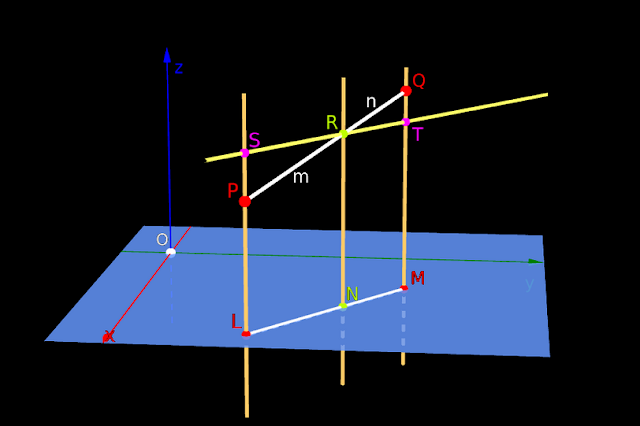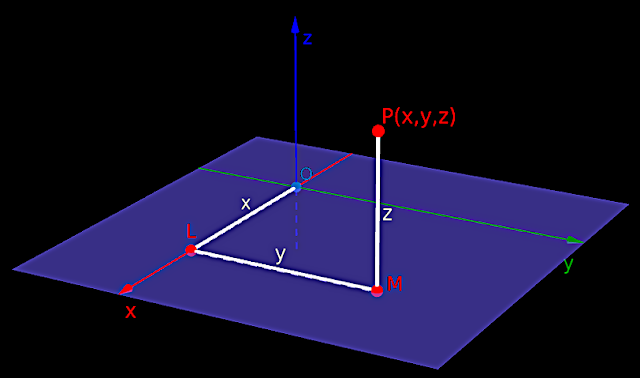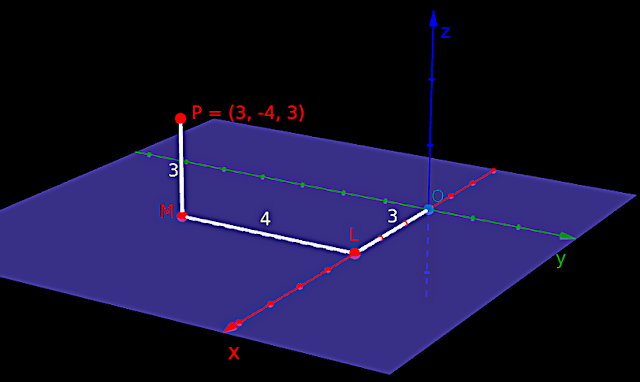In the previous section,
we accomplished two tasks:
Task 1:
To find the coordinates of a point with reference to x, y and z-axes.
Task 2: To mark a point in space when the coordinates of that point are given.
(Task 2 is the converse of task 1)
•
The same two tasks can be accomplished using another method. In this section, we will see this new method.
◼ First we will see task 1:
• In fig.12.7 below, P is a point in space.
 |
| Fig.12.7 |
• We want to write the position of P. It can be done in 4 steps:
1. The first step always is to draw a plane.
• This plane should be:
♦ Passing through P.
♦ Parallel to the YZ-plane.
• In the fig.12.7 above, this plane is shown in gray color.
• Mark the point A where this plane intersects the x-axis.
♦ Measure the length OA.
• This length is indicated as ‘x’.
♦ If A is on the +ve side of the x-axis, then x is +ve.
♦ If A is on the -ve side of the x-axis, then x is -ve.
2. The second step always is to draw a second plane.
• This plane should be:
♦ Passing through P.
♦ Parallel to the XZ-plane.
• In the fig.12.7 above, this plane is shown in yellow color.
• Mark the point B where this plane intersects the y-axis.
♦ Measure the length OB.
• This length is indicated as ‘y’.
♦ If B is on the +ve side of the y-axis, then y is +ve.
♦ If B is on the -ve side of the y-axis, then y is -ve.
3. The third step always is to draw a third plane.
• This plane should be:
♦ Passing through P.
♦ Parallel to the XY-plane.
• In the fig.12.7 above, this plane is shown in magenta color.
• Mark the point C where this plane intersects the z-axis.
♦ Measure the length OC.
• This length is indicated as ‘z’.
♦ If C is above the XY-plane, then z is +ve.
♦ If C is below the XY-plane, then z is -ve.
4. The fourth and final step always is to write x, y and z together as an ordered triplet: (x,y,z)
• To specify the position of point P, we write: P(x,y,z)
Let us see two examples.
Example 1:
This can be written in 5 steps:
1.
In fig.12.8 below, P is a point in space. Let us assume that, it's
position is not known. Our task is to find it's position with reference
to the three axes.
 |
| Fig.12.8 |
2.
First we draw a plane.
• This plane is:
♦ Passing through P.
♦ Parallel to the YZ-plane.
• In the fig.12.8 above, this plane is shown in white color.
♦ This plane intersects the x-axis at A
♦ Length OA is 3 units.
♦ A is on the +ve side of the x-axis. So x = 3
3.
Next we draw another plane.
• This plane is:
♦ Passing through P.
♦ Parallel to the XZ-plane.
• In the fig.12.8 above, this plane is shown in yellow color.
♦ This plane intersects the y-axis at B.
♦ Length OB is 4 units.
♦ B is on the -ve side of the y-axis. So y = -4
4.
Next we draw a third plane.
• This plane is:
♦ Passing through P.
♦ Parallel to the XY-plane.
• In the fig.12.8 above, this plane is shown in magenta color.
♦ This plane intersects the z-axis at C.
♦ Length OC is 3 units.
♦ C is on the +ve side of the z-axis. So z = 3
5. So we can write the coordinates of P as: P(3,-4,3)
Example 2:
This can be written in 5 steps:
1. In fig.12.9 below, P is a point in space. Let us assume that, it's position is not
known. Our task is to find it's position with reference to the three
axes.
 |
| Fig.12.9 |
2.
First we draw a plane.
• This plane is:
♦ Passing through P.
♦ Parallel to the YZ-plane.
• In the fig.12.9 above, this plane is shown in gray color.
♦ This plane intersects the x-axis at A
♦ Length OA is 4 units.
♦ A is on the -ve side of the x-axis. So x = -4
3.
Next we draw another plane.
• This plane is:
♦ Passing through P.
♦ Parallel to the XZ-plane.
• In the fig.12.9 above, this plane is shown in yellow color.
♦ This plane intersects the y-axis at B.
♦ Length OB is 3 units.
♦ B is on the +ve side of the y-axis. So y = 3
4.
Next we draw a third plane.
• This plane is:
♦ Passing through P.
♦ Parallel to the XY-plane.
• In the fig.12.9 above, this plane is shown in magenta color.
♦ This plane intersects the z-axis at C.
♦ Length OC is 5 units.
♦ C is on the -ve side of the z-axis. So z = -5
5. So we can write the coordinates of P as: P(-4,3,-5)
◼ Now we will see how task 2 is accomplished using this method.
•
Consider fig.12.7 that we saw at the beginning of this section. For convenience, it is shown again below:
 |
| Fig.12.7 |
•
We are given the coordinates (x,y,z) of point P. We want to mark that point P in space. It can be done in 4 steps:
1. The first step always is to start from O and move along the x-axis.
♦ If the given ‘x’ is +ve, we must move in the +ve x direction.
♦ If the given ‘x’ is -ve, we must move in the -ve x direction.
•
Mark a point A in such a way that, OA = x units.
• Now draw a plane. This plane should be:
♦ Passing through A.
♦ Parallel to the YZ-plane.
• In the fig.12.7 above, this plane is shown in gray color.
2. The second step always is to start from O and move along the y-axis.
♦ If the given ‘y’ is +ve, we must move in the +ve y direction.
♦ If the given ‘y’ is -ve, we must move in the -ve y direction.
•
Mark a point B in such a way that, OB = x units.
• Now draw a plane. This plane should be:
♦ Passing through B.
♦ Parallel to the XZ-plane.
• In the fig.12.7 above, this plane is shown in yellow color.
3. The third step always is to start from O and move along the z-axis.
♦ If the given ‘z’ is +ve, we must move in the +ve z direction.
♦ If the given ‘z’ is -ve, we must move in the -ve z direction.
•
Mark a point C in such a way that, OA = x units.
• Now draw a plane. This plane should be:
♦ Passing through C.
♦ Parallel to the XY-plane.
• In the fig.12.7 above, this plane is shown in magenta color.
4. The point of intersection of the three planes is the position of P.
Let us see two examples.
Example 1:
This can be written in 5 steps:
1. Consider the fig.12.8 that we saw earlier. For convenience, it is shown again below:
 |
| Fig.12.8 |
2. First we start from O and move along the x-axis.
•
Since the given x is +ve, we move along the +ve direction of x-axis.
•
We mark the point A in such a way that, length of OA is 3 units.
• Now draw a plane. This plane should be:
♦ Passing through A.
♦ Parallel to the YZ-plane.
• In the fig.12.8 above, this plane is shown in white color.
3. Next we start from O and move along the y-axis.
•
Since the given y is -ve, we move along the -ve direction of y-axis.
•
We mark the point B in such a way that, length of OB is 4 units.
• Now draw a plane. This plane should be:
♦ Passing through B.
♦ Parallel to the XZ-plane.
• In the fig.12.8 above, this plane is shown in yellow color.
4. Next we start from O and move along the z-axis.
•
Since the given z is +ve, we move along the +ve direction of z-axis.
•
We mark the point C in such a way that, length of OC is 3 units.
• Now draw a plane. This plane should be:
♦ Passing through C.
♦ Parallel to the XY-plane.
• In the fig.12.8 above, this plane is shown in magenta color.
5. The point of intersection of the three planes is the position of P.
Example 2:
This can be written in 4 steps:
1. Consider the fig.12.9 that we saw earlier. For convenience, it is shown again below:
 |
| Fig.12.9 |
2. First we start from O and move along the x-axis.
•
Since the given x is -ve, we move along the -ve direction of x-axis.
•
We mark the point A in such a way that, length of OA is 4 units.
• Now draw a plane. This plane should be:
♦ Passing through A.
♦ Parallel to the YZ-plane.
• In the fig.12.9 above, this plane is shown in gray color.
3. Next we start from O and move along the y-axis.
•
Since the given y is +ve, we move along the +ve direction of y-axis.
•
We mark the point B in such a way that, length of OB is 3 units.
• Now draw a plane. This plane should be:
♦ Passing through B.
♦ Parallel to the XZ-plane.
• In the fig.12.9 above, this plane is shown in yellow color.
4. Next we start from O and move along the z-axis.
•
Since the given z is -ve, we move along the -ve direction of z-axis.
•
We mark the point C in such a way that, length of OC is 5 units.
• Now draw a plane. This plane should be:
♦ Passing through C.
♦ Parallel to the XY-plane.
• In the fig.12.9 above, this plane is shown in magenta color.
5. The point of intersection of the three planes is the position of P.
From the above discussion, we can write three important points:
1. Consider any point P(x,y,z) in space.
♦ x will be the distance of P from the YZ-plane.
♦ y will be the distance of P from the XZ-plane.
♦ z will be the distance of P from the XY-plane.
2. If P is situated on any one of the three axes, then two of it’s coordinates will be zeroes.
♦ If P is on the x-axis, then it’s coordinates will be in the form P(x,0,0).
♦ If P is on the y-axis, then it’s coordinates will be in the form P(0,y,0).
♦ If P is on the z-axis, then it’s coordinates will be in the form P(0,0,z).
3. If P is situated on any one of the three planes, then one of it’s coordinates will be zero.
♦ If P is on the XY-plane, then it’s coordinates will be in the form P(x,y,0).
♦ If P is on the XZ-plane, then it’s coordinates will be in the form P(x,0,z).
♦ If P is on the YZ-plane, then it’s coordinates will be in the form P(0,0,z).
• Using the signs of the three coordinates of a point P, we can easily write the octant in which P is situated. We mentioned this in the previous section.
• The converse is also possible. That is., if we are given any of the eight octants, we can easily write the signs of the coordinates of points in that octant.
• Let us see two examples:
Example 1:
What are the signs of the coordinates of points in octant II?
Solution:
1. Octant II is one of the first four octants.
♦ So we directly consider quadrant II.
♦ Name of quadrant II is X’OY
2. Since octant II is one of the first four octants, we can put Z.
♦ So the name of the octant II is X`OYZ
3. Based on this name, the signs are: -ve, +ve, +ve
Example 2:
What are the signs of the coordinates of points in octant VII?
Solution:
1. Octant VII is one of the last four octants.
• The octant occurring above octant VII is: (7-4) = octant III
♦ So we consider quadrant III.
♦ Name of quadrant III is X’OY’
2. Since octant VII is one of the last four octants, we can put Z’.
♦ So the name of the octant VII is X`OY’Z’
3. Based on this name, the signs are: -ve, -ve, -ve
Now we will see some solved examples.
Solved example 12.1
In fig.12.10 below, the coordinates of P are (2,4,5). What are the coordinates of the point F ?
 |
| Fig.12.10 |
Solution:
1. The gray plane is parallel to the YZ-plane. So all points on the gray plane will have the same x-coordinate.
• P(2,4,5) lies on the gray plane. So all points on the gray plane will have the x-coordinate ‘2’
• The point F lies on the gray plane. So the x-coordinate of F is ‘2’.
2. The magenta plane is parallel to the XY-plane. So all points on the magenta plane will have the same z-coordinate.
• P(2,4,5) lies on the magenta plane. So all points on the magenta plane will have the z-coordinate ‘5’.
• The point F lies on the magenta plane. So the z-coordinate of F is ‘5’
3. The point F lies on the XZ-plane.
• All points on the XZ-plane will have the y-coordinate as zero.
4. Based on the above three steps, we get the coordinates of F as: (2,0,5)
Solved example 12.2
Find the octants in which the points (-3,1,2) and (-3,1,-2) lie.
Solution:
Case 1: (-3,1,2)
1. The signs are: -ve, +ve, +ve
♦ Based on the first two signs, we can write: X’OY
♦ Based on the last sign, we get: Z
• So the name of the octant is X’OYZ
• Since Z is +ve, it is one of the first four octants.
2. The first three letters of the name are: X’OY.
• This corresponds to the quadrant II
3. Since it is one of the first four octants, the names of quadrants and octants are same.
• We get: octant II
Case 2: (-3,1,-2)
1. The signs are: -ve, +ve, -ve
♦ Based on the first two signs, we can write: X’OY
♦ Based on the last sign, we get: Z’
• So the name of the octant is X’OYZ’
• Since Z is -ve, it is one of the last four octants.
2. The first three letters of the name are: X’OY.
• This corresponds to the quadrant II
3. Since it is one of the last four octants, we must add 4.
♦ 2+4 = 6
• We get: octant VI
The link below gives a few more solved examples:
Exercise 12.1
In the next section, we will see distance between two points.
Previous
Contents
Next
Copyright©2023 Higher secondary mathematics.blogspot.com


















